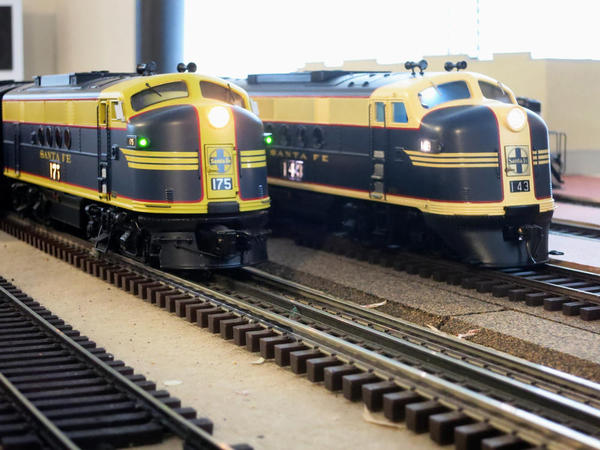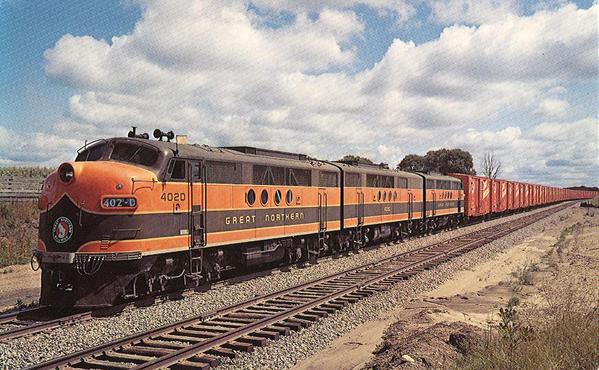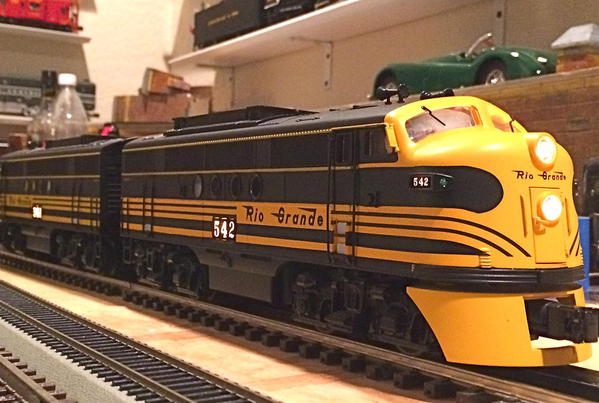Hey, Matt!
Regarding the remark in your post above concerning "hostler cabs", that tells me that you know your first generation diesels very well! I've always admired you for being a detail-oriented guy, and that proves it.
When I was a kid, we were too poor for me to have a set of Lionel F3s, but I had school pals who did. Few things in my youth held more fascination for me than the Lionel Warbonnet F3s, at least until I discovered that girls weren't as bad as we guys had thought! But that's another story.
Whenever I got the chance, I studied my buddies' F3s as closely as I could, from those gorgeous silver Blomberg trucks, to the tiniest details on the carbodies, memorizing them with crystal clear Technicolor 3-D clarity.
I wondered endlessly about what function they all served in the operation of the locomotive, for instance the wire-mesh rectangular grills on the roof just aft of the control cab (dynamic brake grid cooling vents), or the circular conical devices further back between the exhaust stacks (engine radiator cooling fan housings), and the cast-in circular knurled caps ahead of the cab and engine-access doors in the sides of the carbodies (sand filler ports). Back when I was eight years old, the functions of these F3 details were beyond my wildest speculation, and certainly increased my fascination with the Lionel models and their prototypes.
Of those details that I observed, perhaps the most curious were the three square and one rectangular holes in the vertical rear panel, flanking the vestibule door into the engine's interior (see 9th thumbnail image from the left, showing F3 carbody end detail):
http://www.ebay.com/itm/201219785938
55 years later, while reading Dr. Cynthia Priest's remarkably well-researched book on Santa Fe diesels, I learned that the B-units had "hostler cabs" at one end so that a servicing yard crewmember (hostler) had a rudimentary set of controls for maneuvering an otherwise "cabless" B-unit when uncoupled from it's normally paired A-unit. These "hostler cabs" had windows so the crewmember could see where he was going within the engine servicing facility. That finally satisfied my curiosity about the purpose of those cast-in unglazed square holes! Of course, when Lionel created the tooling for the Warbonnets, they missed a couple of important distinctions which may have added confusion to this topic. The original set consisted of a pair of A-units, one powered and one not. Originally there was no B-unit produced. Nonetheless, the artisans at the New Jersey factory, apparently looking at photos of F3s picked up the carbody end detail from a B-unit (i.e. including the windows for the hostler) and incorporated them (albeit inaccurately to boot) into the rear end vertical panel of the 2343 tooling, oblivious to the fact that an A-unit equipped with a full crew cab wouldn't need or have a hostler's cab in the other end! And while we're on the subject, the B-units had small single headlights mounted above the hostler's line of sight so he could see while maneuvering an orphan B-unit in the yard at night. Lionel's tooling designers, for whatever reason, omitted that detail from the body casting.
Louis Marx, the Chevrolet to Lionel's Cadillac in the toy train market, also produced an F unit Warbonnet of their own in the early '50s, presumably trying to cash in on the Warbonnet craze in full swing at the time:
http://www.buymarxtoys.com/wp-...3203909469054720.jpg
Marx's answer to Lionel's 2343 A-A set was a much cheaper sheet metal ("tinplate") lithographed version of a Warbonnet FT passenger locomotive. I say it was an FT because it had the distinctive set of five circular portholes instead of the two or three-porthole (depending on the EMD F3 production "phase") F3 through F9 versions. Similar to the nonsensical error regarding the anomalous hostler cab windows in the rear of Lionel's 2343 A-units, Marx committed the same booboo by lithographing not four but two square representations of hostler windows into their A units as well. The Marx Warbonnets, despite the FT-like arrangement of four portholes were to today's toy train buff a mishmash of features and erroneous omissions apparently incorporated from different EMD F-unit models. For example, the Marx Warbonnet roofs have the correct arrangement of cooling fans and lithographed exhaust ports for models F3 and later rather than the rectangular flattop exhaust and cooling vent arrangement of FTs. The truck frames are castings designed to look like three-axle units appropriate to EMD's double-diesel family of passenger E-units rather than the two axle Blomberg models found on all F-units. Although usually thought of as freight engines, Santa Fe did order and operate Warbonnet schemed FTs in passenger service. Here's a black and white photo of a set pulling a heavyweight Pullman consist:
http://www.wig-wag-trains.com/...ries-Locos/p26f1.jpg
My 1950 Marx Warbonnet set however came with freight, not passenger equipment. Back then, and perhaps to a lesser extent today, toy train manufacturers were much more intent on making an emotionally evocative product for kids of all ages including geezers like me to play with and for parents to buy for them than they were interested in scrupulously prototypical accuracy. Thus, both Lionel and Marx managed to miss some key prototype-specific detail distinctions when they created their tooling and lithography in the post-war period of the late 1940s and early 1950s.
The good news is that today's nostalgic collector and operator of O gauge trains, whether from the '40s or today, can have an ever increasing selection of more and more accurate scale renditions of the original prototypes. The MTH and 3rd Rail/Sunset versions of EMD's paradigm-shifting FTs are both admirable efforts in my estimation!
By the way, I just looked at my ABBA set of MTH Premier Warbonnet F3s, and neither the A- or B-units have hostler cab windows cast into the end panels!
Fascinating subject, Howard, thanks for posting. I'm afraid I rambled way off-topic, sorry.
WarbonnetsForeverBear














